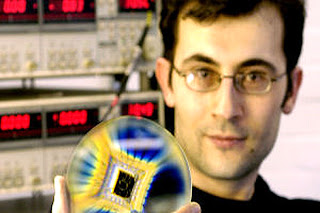The world’s thinnest, strongest and most conductive material, discovered in 2004 at the University of Manchester by Professor Andre Geim and Professor Kostya Novoselov, has the potential to revolutionize material science.
Demonstrating the remarkable properties of graphene won the two scientists the Nobel Prize for Physics last year and Chancellor of the Exchequer George Osborne has just announced plans for a £50m graphene research hub to be set up.
Now, writing in the journal Nature Physics, the University of Manchester team have for the first time demonstrated how graphene inside electronic circuits will probably look like in the future.
By sandwiching two sheets of graphene with another two-dimensional material, boron nitride, the team created the graphene ‘Big Mac’ – a four-layered structure which could be the key to replacing the silicon chip in computers.
Because there are two layers of graphene completed surrounded by the boron nitride, this has allowed the researchers for the first time to observe how graphene behaves when unaffected by the environment.
Dr Leonid Ponomarenko, the leading author on the paper, said: “Creating the multilayer structure has allowed us to isolate graphene from negative influence of the environment and control graphene’s electronic properties in a way it was impossible before.
It solves several nasty issues about graphene’s stability and quality that were hanging for long time as dark clouds over the future road for graphene electronics.
"We did this on a small scale but the experience shows that everything with graphene can be scaled up.”
“It could be only a matter of several months before we have encapsulated graphene transistors with characteristics better than previously demonstrated.”
Graphene is a novel two-dimensional material which can be seen as a monolayer of carbon atoms arranged in a hexagonal lattice.
Its remarkable properties could lead to bendy, touch screen phones and computers, lighter aircraft, wallpaper-thin HD TV sets and superfast internet connections, to name but a few.
The £50m Graphene Global Research and Technology Hub will be set up by the Government to commercialise graphene. Institutions will be able to bid for the money via the Engineering and Physical Sciences Research Council (EPSRC) – who funded work leading to the award of the Nobel prize long before the applications were realised.
Contact: Daniel Cochlin daniel.cochlin@manchester.ac.uk 44-161-275-8387 University of Manchester












No comments:
Post a Comment